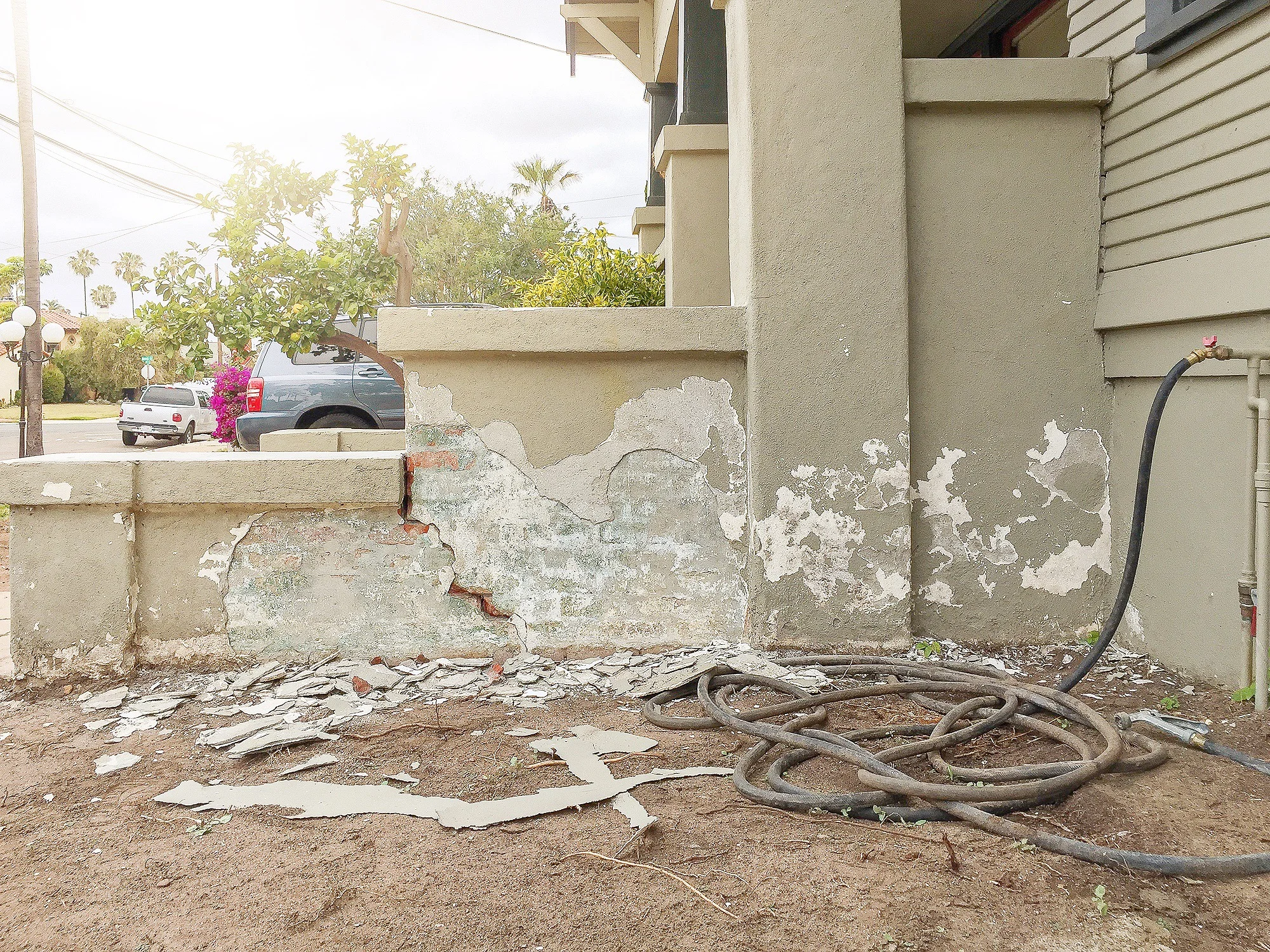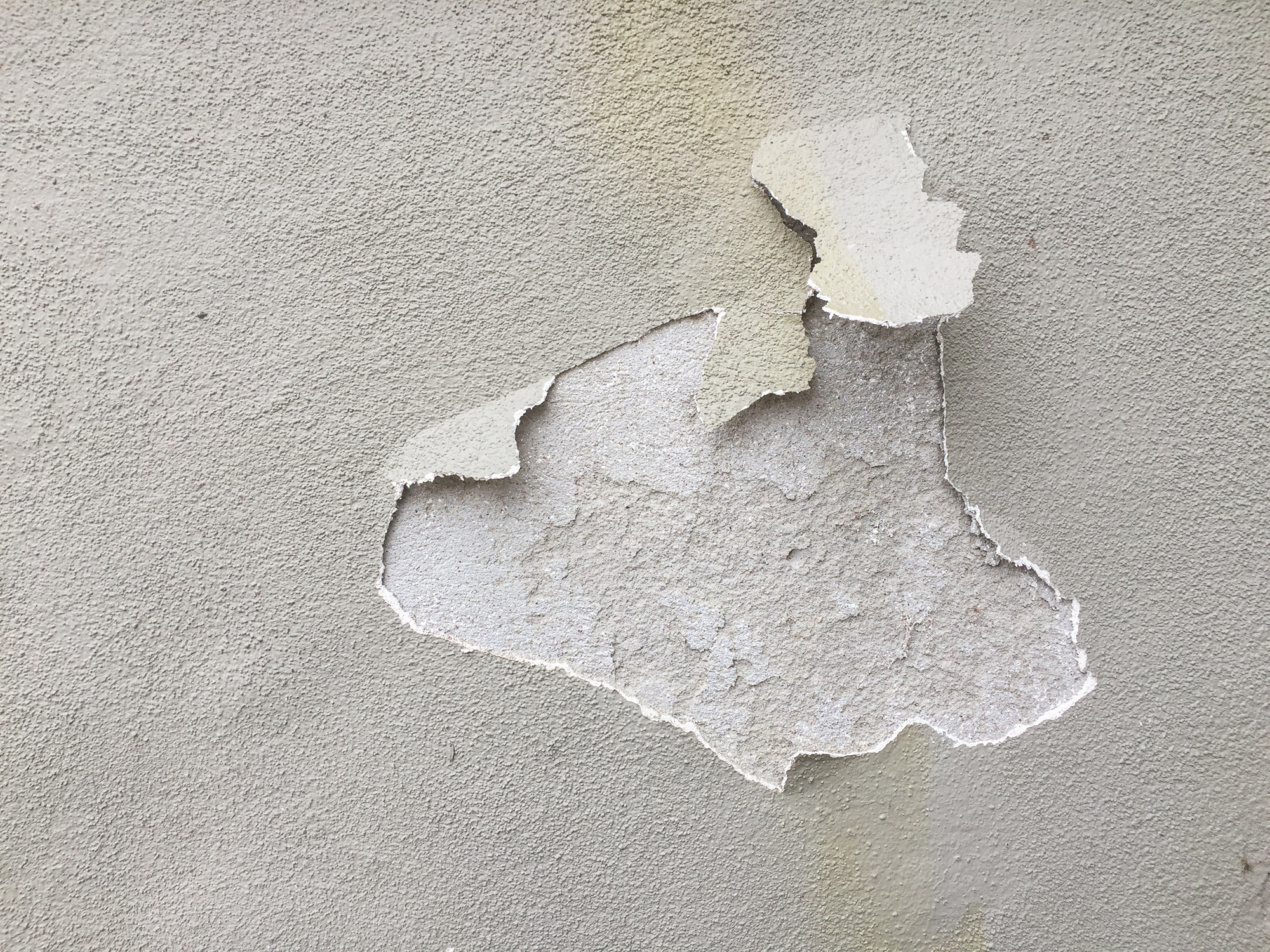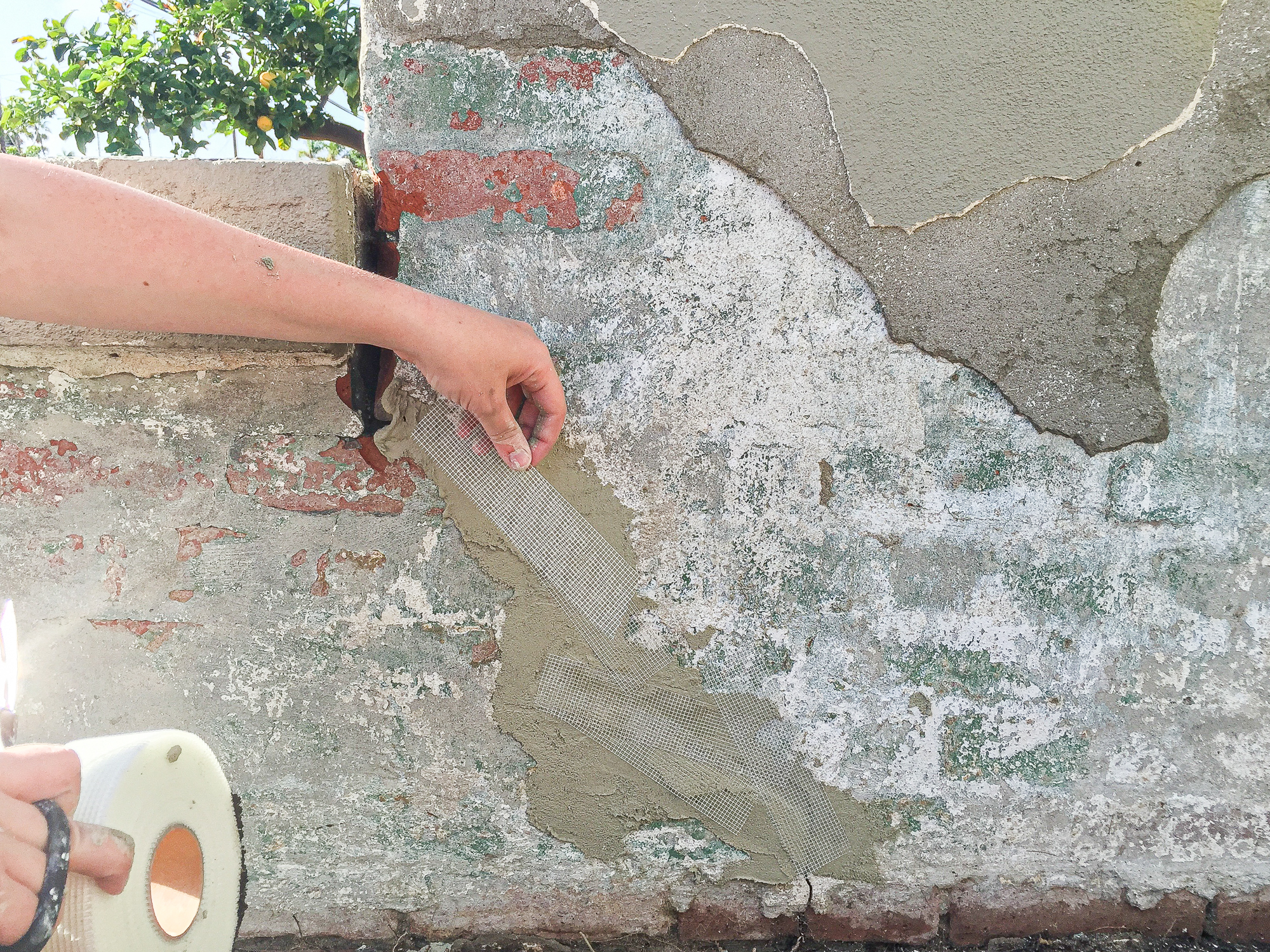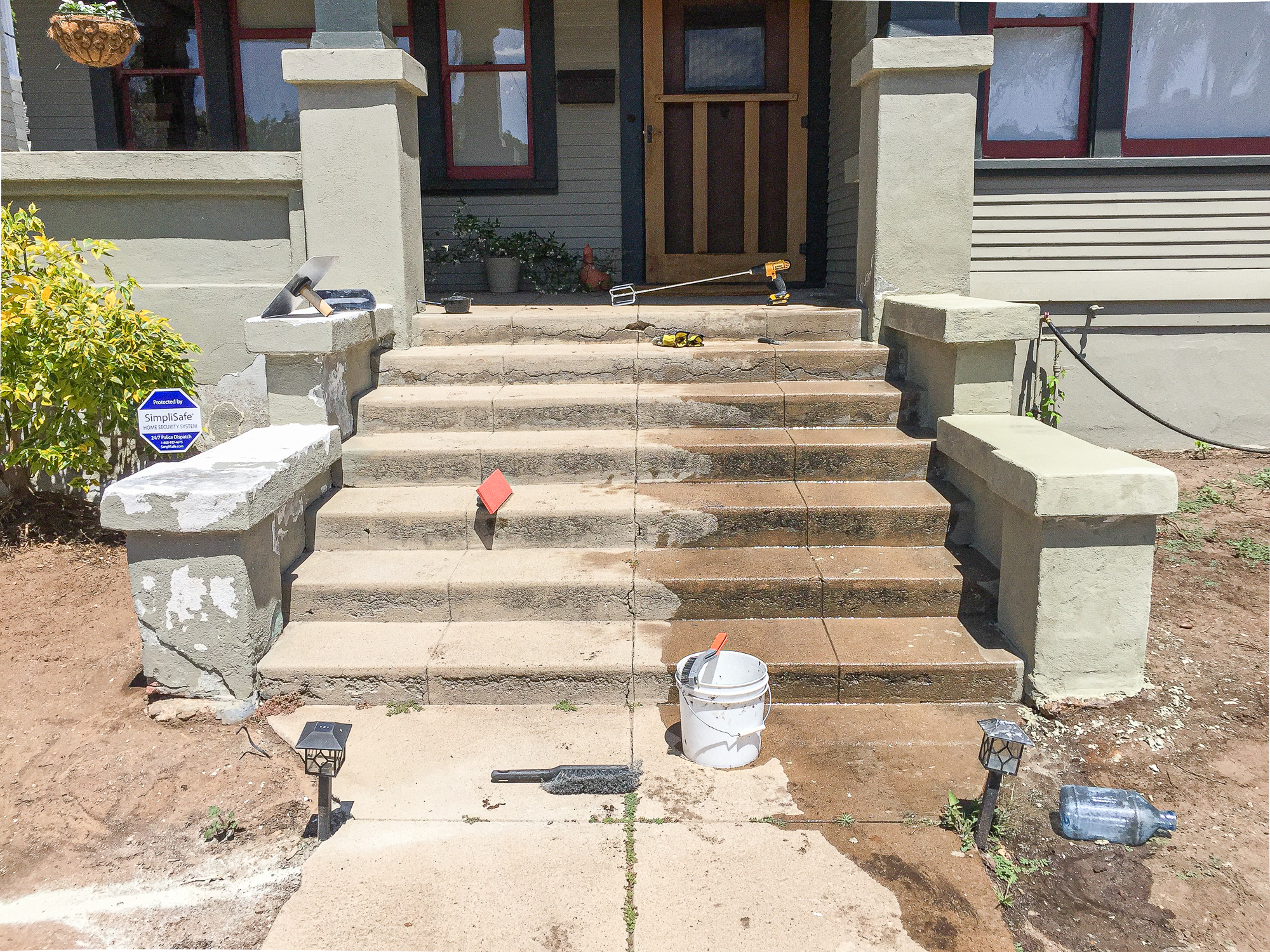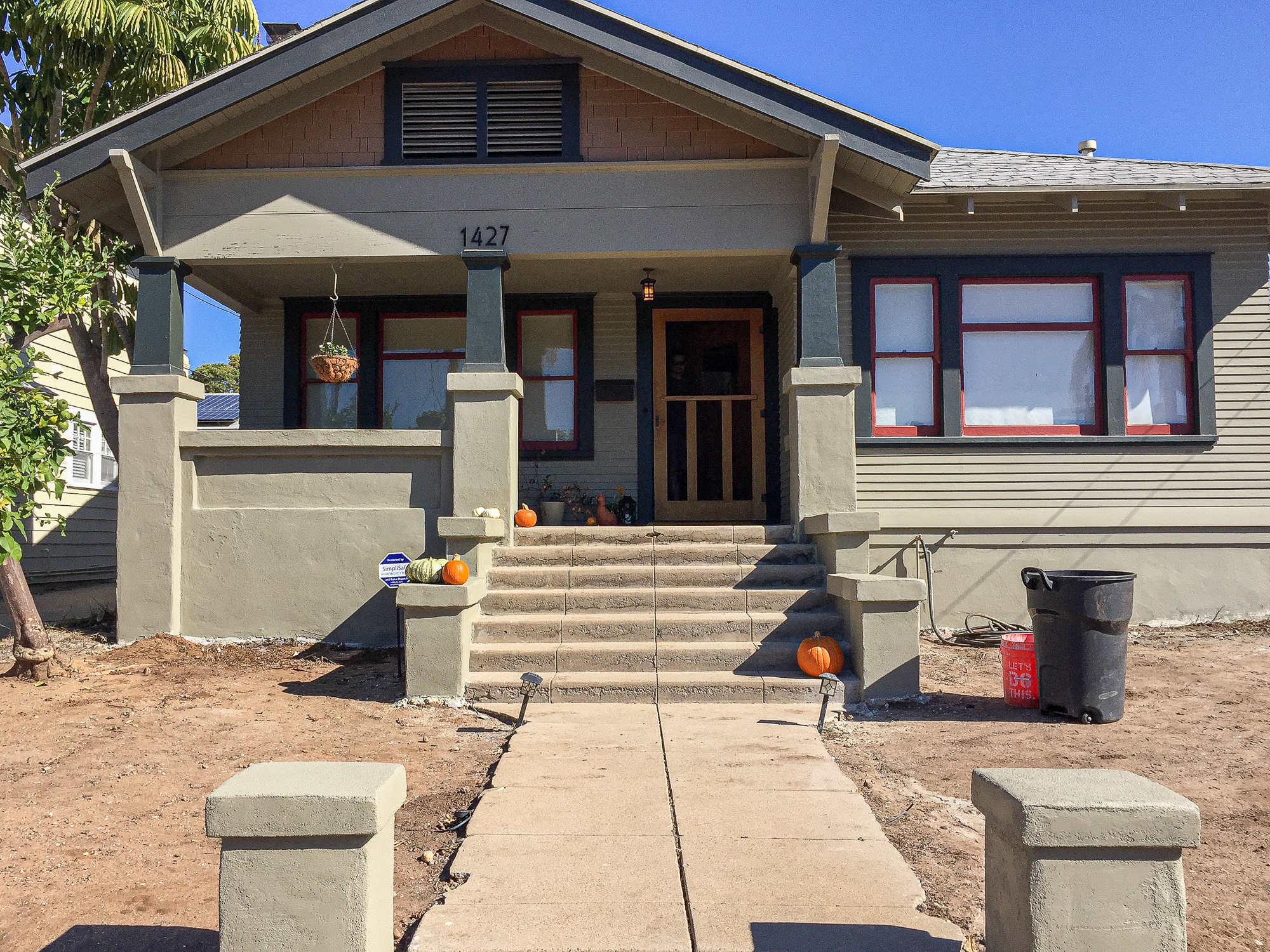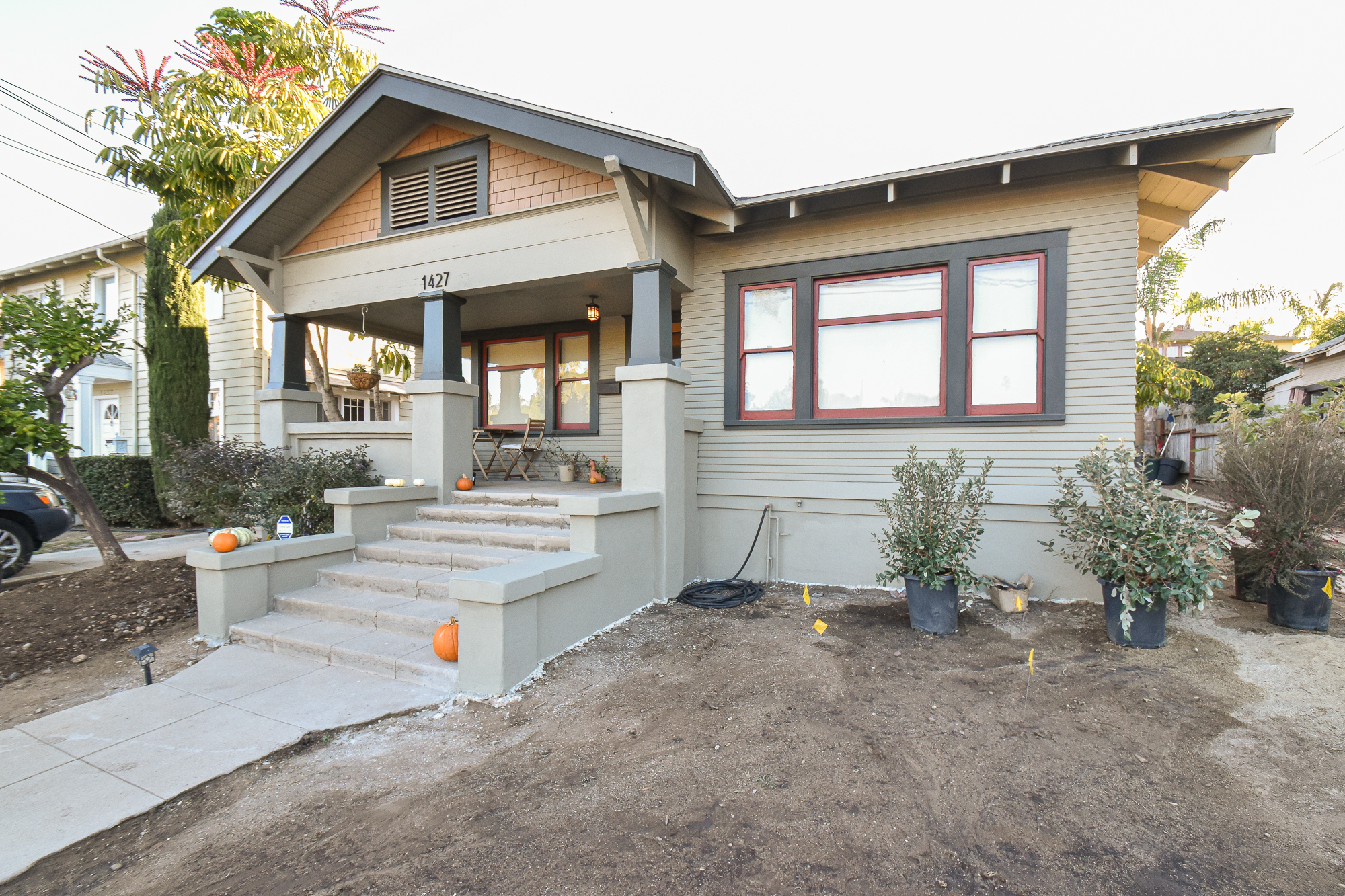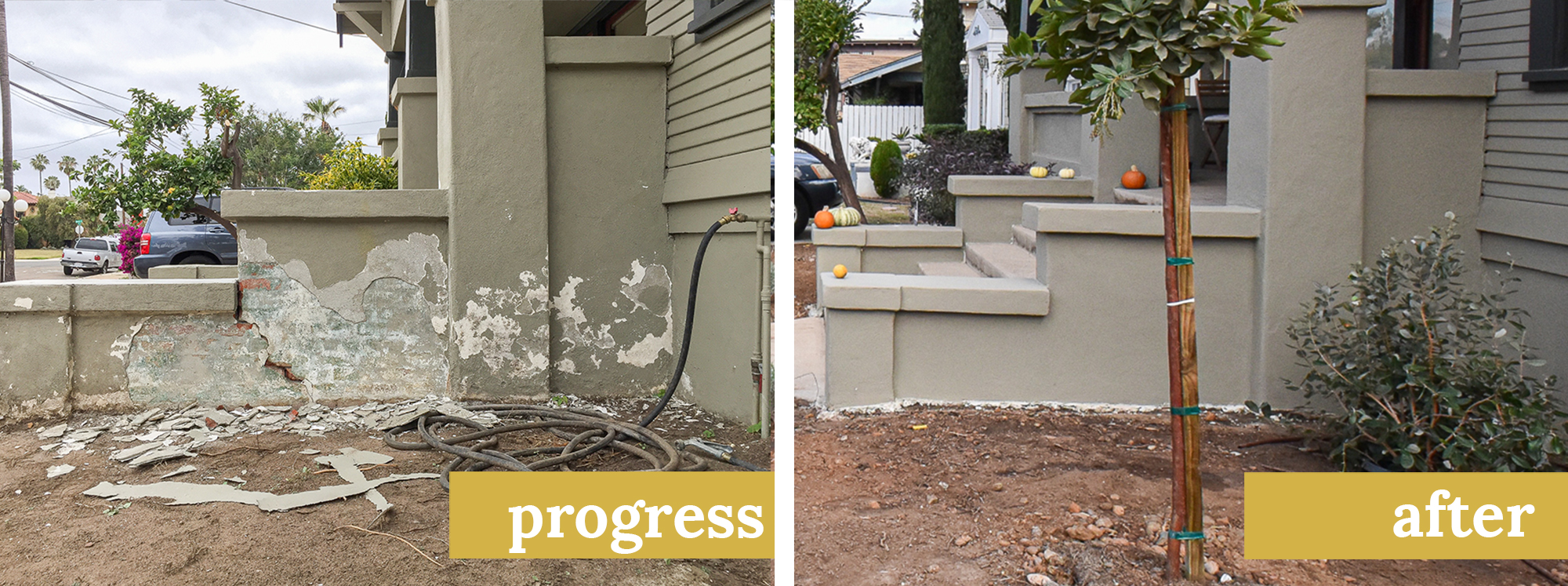Repairing the Stucco on the Outside of the House
/It’s about time I share more about our landscaping project that I’ve been teasing about for awhile. I last left off sharing how I saved thousands of dollars and saved foliage from the landfill when trying to clear out our front yard to make way for new plantings.
Once we removed the existing plantings and admired our dirt pile, it became obvious that there was some stucco repair to be done. I’m here to share what I did, how I did it, and give you some satisfying before and afters to enjoy.
Now, I realize this isn’t a DIY project that most people need to do. But I want to share this post to keep you updated on the work that went into the restoration of my home and demonstrate the power of a determined DIYing woman (me). If you have the privilege of time, energy, physical ability, and money, you can do nearly any home improvement project - even the unglamorous ones. Plus, I took a bunch of photos, so I need to publish them on the internet - If I don’t prove I did it, did the project didn’t even happen??
If you haven’t already, click here for a preview of all of my posts about the curb appeal of the house including the befores, the new roof, managing the foliage, and my favorite gardening tools.
Our house is primarily wood siding, but the foundation and porch are all stucco over brick. After the distracting dead plants were removed, the damaged stucco became the new eyesore.
Pieces were cracked, flaking, or missing. Some was coming off because vines got in behind the finish coat of stucco. Luckily, it wasn’t structural so there was no urgency to repair it, but if there was a time fix it, it’d be when the perimeter of the house was free of foliage.
So, I got to work. I somehow ended up doing this project in the dead heat of summer, without shade, and sitting on soil infested with ants. There are way worst projects to do out there, but if you do this one, I don’t recommend doing it in when it’s blazing hot out and maybe wear those boot/pants that fishermen wear to prevent the ant bites.
I got to work with my trusty 6-in-1 tool to chip away all of the stucco that was loose. Then cleaned off the flaky edges with a wire brush. I scraped off the finish coat and the base coat - anything loose, it came off.
I scraped
and scraped
and scraped
and scraped.
What I thought would be a couple of little patch jobs turned into refinishing all of the front porch and big swaths of stucco around the perimeter of the house.
Once I scraped all of the loose pieces off and sufficiently shaved all of the skin off my knuckles, it was time to patch everything back up.
The Supplies:
Drill and mixer attachment or cement mixer
Two 5-gallon buckets
Bucket scoop or just a repurposed small bucket
I spent just over $100 on the floats, hawk & trowel, and mixes (they were cheaper locally than online). All other supplies I already owned.
I got the materials at a building supply place that primarily sells directly to contractors doing major jobs. Most orders are put on a truck bed using a forklift and a palate full of materials. I think I received the tiniest order on a forklift ever (see the single bag in the upper right corner) and loaded it into one of the most non-truck-like automobiles (Prius) - and I’m proud of it.
Disclaimer: I’m going to show you what I did for MY particular project. There are a bunch of products and techniques out there. I highly recommend Kirk’s videos for learning the many different ways to apply finishes with different products. Also I did this project over three years ago, so my memory of all of the step-by-steps is a little rusty.
I did two steps of the stucco process. The base coat and the finish coat. Depending on the job, you can get away with just the finish coat, or if you’re doing a fresh stucco job, you’ll need a scratch coat on top of the wire mesh. But, I’m not going to cover that since I didn’t do it.
No matter what project you’re doing, you’ll want to spend about 100 hours watching Kirk Giordano videos on YouTube. Even if you aren’t doing this project, you’ll still want to watch because his cadence makes me chuckle and he’s super informative. I also find these videos as satisfying as watching people make a cake. I’m going to reference Kirk several times in this post because I owe everything I know to him.
ANYWAY. Here’s what I did in summary.
1. Scrape away loose materials
I shared this above, but I must repeat again that removing loose pieces and dust is super duper important. New material won’t stick to the flaky dusty stuff.
Side note. There’s something that I really like about revealing the brick underneath the stucco. It’s such a beautiful reminder of the work that went into building my house over 100 years ago. I find it kinda neat to touch the piece of brick that someone else touched but hasn’t been seen for 100 years. Ya know what I mean?
2. Mist the surface with a hose
Misting cleans off the surface and adds moisture to the brick to aid in the adhesion. Without the water, the brick might pull too much water out of the mud and then the cement won’t cure properly.
3. Mix the base coat
For my project, I chose to do a base coat to fill in the deep cavities and imperfections. Some folks only use a color coat but since that needs to be applied so thinly, it would have required 8 or so layers, and I didn’t want to do this 8 times. Two coats would be enough for me. I went for a base coat that I could make extra thick, then put a color coat on top to get the texture I wanted.
I used this for my base coat. It’s a portland cement with added polymers for adhesion and support. It’s designed for EXACTLY what I was doing - filling cracks and preparing for a finish coat. Some folks recommend painting an adhesive glue on the wall before applying portland cement, but this was basically a 2-in-1 so it saved me a step.
Since I was only one person, I couldn’t work with too much mud at a time or else it would all dry out. Because I was mixing small batches, I didn’t need a heavy-duty cement mixer so using my drill with a cement mixer attachment worked perfectly for me. If I had a team of helpers, the drill may not have had the power to keep up.
I used a big bucket that I had on hand to add water and dry mix. I followed the package instructions which said to mix to a peanut butter consistency then let it sit for 5 minutes. I do as I’m told.
4. Use the hawk and trowel to apply the mud
Once the mud was mixed in the big bucket, I scooped it onto my hawk. You can use a professional bucket scoop or dump the whole bucket of mud onto a tabletop. But I used an empty hummus container. Because I’m extra professional.
The hawk is basically a flat piece of metal on a handle designed kinda like you’re holding an ice cream cone with a pizza box glued on top. It lets you hold the mud on it but also lets you easily scrape it onto the trowel. It takes some practice to get the hang of how to use it, but once you get going it becomes second nature. I liked using a “pool trowel” because it had curved corners which made the application more forgiving for a newbie.
Apply the mud with the trowel always from the bottom up. At first, the goal is to get the mud on the wall, then after everything got coverage, I went over it with the trowel to smooth it out and feather the edges into the existing stucco. This description I gave is not enough, you definitely need to watch Kirk in action.
5. Make repairs to major cracks
I had a big crack at the stairs that I wanted to reinforce while I was at it. There are a few different options out there from filling with special exterior caulk to just filling with the base coat. At the recommendation of the nice man at the building supply company, I tossed on a few pieces of fiberglass mesh tape that I already had on hand from when I did interior wall repair. Then, I coated over the tape with a thin coat of the base mud. Who knows if those pieces did anything, but it’s three years later and there’s not even a ghost of the crack anymore.
6. Float the mud
The trowel is designed to get the mud on the wall, then the sponge float is designed to smooth it all out. There are two types of floats out there - the red float and the green float. Kirk demonstrates them both here but in summary the red float is designed to compact the mud and the green one is designed to bring the sand in the mud to the surface to create texture. For the base coat, I wasn’t aiming for a texture. My goal was to smooth out the fresh mud, blend it into the existing finish, and ensure It got into all the cracks. So I used a red float. (I used the green one on the finish coat.)
This is where the second bucket comes in handy. The first one is holding the mud, but the second one is for plain ‘ol water which is necessary for rinsing the float. I dunked the float in the water, tapped it on the side of the bucket to flick off the excess water, then rubbed the float on the wall in sorta-circular motions. I wasn’t too concerned with the look of the texture since I was going to cover it up, but the base coat is laying the groundwork for the top coat, so making sure it’s smooth and there aren’t any bumpy transitions into the existing finish is key.
As the float filled up with mud, or if I felt too much of a drag, I’d dunk it in the bucket and re-rinse. Then, I’d repeat over and over and over and over smoothing out all of the mud before it hardened. Using circular motions I feathered out the fresh mud until it was all smooth.
I worked in sections making my way around the perimeter of the house. On the right is the finished base coat and the left is only scraped and ready for its base coat. I made sure to prep, apply, and float only enough mud that I could tackle before it dried out completely.
Here’s the “finished” base coat. It’s still really rough, but the surface is smooth, the edges are clean, and it’s a solid foundation for the upcoming finish coat.
7. Float the finish coat
The finish coat follows all of the above steps, so I won’t repeat them. But, instead of using the base material, I used a finishing coat stucco. This is the part where you need to research YOUR particular finish. Since I was doing repairs, my goal was to match the existing finish, but if you’re doing a fresh project, you can pick your favorite texture. When eyeing the existing texture, keep in mind that it likely has several coats of paint on it, so your new mud texture might be grittier than what you see on your walls.
I used a 20/30 texture to match the existing stucco on my particular home. The irony is I basically re-stuccoed the whole house so I could have picked any finish. Luckily I like the fine texture of the 20/30.
I applied the stucco with the hawk and trowel just as before, but this is the stage when I followed up with the trusty green float. For this stage, the float’s goal beyond evening out the surface is to create texture. The action of swirling the wet float brings out the sand in the finish which gives it the desired texture. Since this is the final surface coat, I made extra sure to feather the mud into the existing top coat so it wouldn’t look like there was new stucco.
In the photo above you can look closely to see the finish coat is applied on the sides but not the top of the columns. Notice the gritty surface on the sides but not the top? I worked my way around and paid super close attention to the edges to make sure there weren’t any sharp corners. I would sometimes circle back to a previous spot and do touch ups just by wetting the float.
8. Let cure
Once everything was retextured, I let it cure. Since water is such a critical part of the adhesion and texture of stucco and cement products, rushing to trap the moisture in with paint is never recommended. Also, rushing to dry it is bad, too. I spent a few weeks watering my stucco to make sure the blazing summer heat didn’t suck the moisture too quickly. After a few days of misting the walls with a garden hose, I waited for Kirk’s recommended 28 days to let it dry out. Our house had these bright white bandaids for a solid month which probably made the neighbors think I forgot about the project. It was clearly a work in progress, okay people?
9. Prime and paint
Once the stucco was fully cured, I painted! There are actually a bunch of finish products that have a built-in color, which is why many are called a “color coat” but I wanted my stucco to match my siding color so I knew I wanted to paint it. I could have tried to get a stucco similar to the siding color, but since I plan on painting all that one day, I wasn’t going to worry about matching a color I didn’t want to keep.
I don’t think I can articulate how gooooood it felt to paint everything after the whole process. I looked back at the time stamps of when I first took photos of scraping the finish and it turns out I took them in early May. Based on the pumpkins on the steps, it’s clear I didn’t get to painting until October/November! It took an entire summer because I was working full time, the materials took time to cure, and I also did a bunch of other projects in between. It took me awhile, but I’m only one person, okay?!
Here’s a nice view of the main area I had to repair. Looks pretty good, eh?? I mean, there was previously a big crack and views to the brick underneath. Can you tell some is new and some is old? The goal with most all of my projects is to look like I never did any repairs. It’s kinda ironic because an unnoticed improvement feels like it negates all the work I did, but that’s how you know it was a job well done.
Like new!
Check out the lower left corner of that column in the foreground. Such a happier lil’ column.
I finished the stucco repair and the fence repair that summer just in time to plant the garden in the fall. Check out the button below for more curb appeal posts and to go ahead in time to see the garden fill in.

